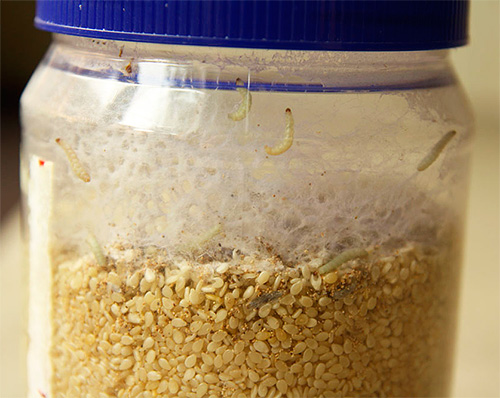
The name "food moth" is popularly understood as several types of moths - small butterflies, whose caterpillars feed on cereals, nuts and groceries. Each of these species has its own characteristics, however, despite the fact that outwardly different types of food moths differ well from each other, no one especially wants to understand them and is simply looking for ways to get rid of these pests as soon as possible.
At the same time, there is no easy and universal instruction on how to remove food moths - due to the specifics of the nutrition of these butterflies, conventional methods such as aerosol insecticides are not suitable (after all, poison can get into food). Therefore, the fight against food moths is always a rather troublesome and resource-intensive event.
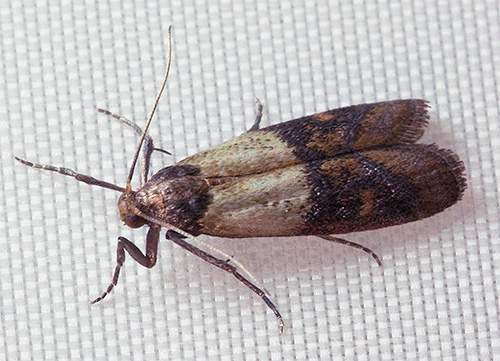
It is interesting
Before the development of human civilization, all types of moths were rather inconspicuous participants in natural biocenoses, and their caterpillars fed on the seeds of grasses and trees. But with the advent of granaries, barns and warehouses, and especially with the start of active transportation of goods between countries and continents, the food moth quickly spread throughout the world and became a real cosmopolitan, infecting grain equally effectively in Argentina, China and Chad.And today, even industrial methods of dealing with food moths do not always cope with its destructive activity.
Types of food moth and features of their morphology
If you look at photos of different types of food moths, you might be surprised how they are generally confused and combined under one name. For example, in the photo below is a flour moth, one of the most common types of food moth in an apartment:
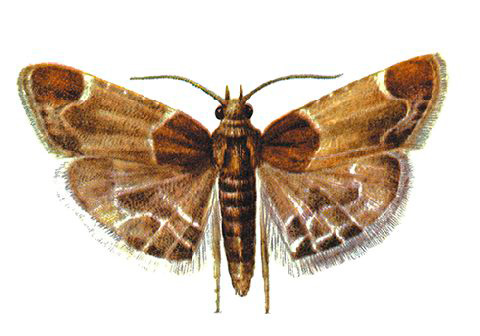
And then the photograph shows a mill moth, less flashy and more rare in residential buildings:
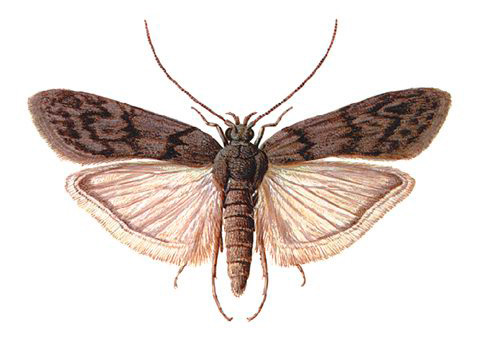
And here is the southern barn moth, which has a beautiful pattern on the wings. Getting it out is often the hardest thing to do:

And in the photo below you can see what a cocoa moth looks like - an ordinary food moth, which is easy to confuse with a wardrobe moth because of the inconspicuous light yellow color of the wings:

But in general, any food moth looks inconspicuous, even despite the pattern on the wings of some of its species. All of them are butterflies of discreet colors and small sizes.
Usually the length of their wings does not exceed 7-8 mm, and sitting on the surface, the insect folds them and becomes like a small protrusion on the surface. It is not surprising that a simple glance of a resident of a city apartment is usually not able to catch the difference in the color of these butterflies.
On a note
For an unprepared resident of a big city, food and clothing moths are very similar. The easiest way to distinguish them is by their meeting places - the clothing moth rarely catches your eye in the kitchen, and the food moth, on the contrary, does not spare wardrobes and bedrooms with its attention.
But the larvae of the food moth are all on the same “face”. These are small (up to one and a half centimeters) white-yellow or white-pink caterpillars without any hair or outgrowths on the body. Usually, by appearance, it is impossible to determine whether a caterpillar belongs to one or another moth.Fortunately, you can breed them all in the same ways, and it is not necessary to determine the species affiliation of the larvae for this.
For example, in the photo below - the larva of the food moth of the flour moth:

And in the next picture - a cocoa moth larva. Even despite the obvious difference in the color of adult butterflies, their larvae are very similar:

On a note
Food moth larvae lead a secretive and sedentary lifestyle. Usually they catch the eye either in contaminated products or when crawling out of pupation cabinets. In this case, they move along the walls and strongly attract attention. In the photo - such an adult and ready to pupate larva of the food moth.
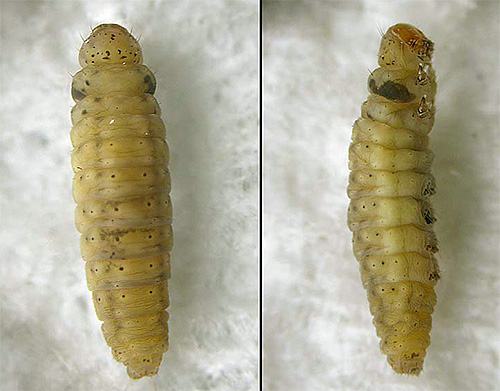
Food moth: a bit of biology
Food moth is a pest with a fairly short reproduction cycle. With suitable temperature and humidity, it takes about two months from egg to egg, and sometimes up to six weeks.
The optimal conditions for the development of food moth butterflies are a temperature of about 25 ° C and a humidity of about 50%. With such air parameters, they develop the fastest, and it turns out to be very difficult to remove them.
Adult food moth butterflies do not feed at all: their mouth apparatus is not developed and the digestive system does not function. Yes, and they do not live very long - about a week, mating literally on the first or second day after leaving the chrysalis. The remaining few days, the females devote to laying a hundred or one and a half eggs where the future offspring will find enough food, and the males look for other females or die.

In general, taking into account the larval stage, the food moth lives for about a month and a half. Of these, a week or two is spent on metamorphosis in the pupal stage.
Almost always, food moth breeds in the same place where its larvae live. Only in some cases, adult insects mate away from the groceries, and the females then return to the feeding environment.
A pest in an apartment: how does it get here, where does it live and what does it eat
Food moth larvae feed on groceries. Moreover, the food moth eats almost everything indiscriminately: cereals, flour, sugar, cocoa, nuts, dried fruits, bread, crackers, cookies, not very hot spices, unground grain, etc.
Food moth larvae are especially numerous in grain warehouses, which can cause significant damage. Each species has its own food preferences, but in general, the range of food products for each moth is wide. In an apartment, any type of food moth feeds on almost any grocery product.
Thus, wherever there is dry food, food moths can start.
In the photo - dry apricots, among which food moth larvae are visible. In case of mass infection of large volumes, it is extremely difficult to remove moths from such a product:

Each food moth larva not only eats the product in which it lives, but also constantly wraps itself in a silk cocoon. So in cereals or flour, “incomprehensible” lumps and spools appear, and in nuts - neat nests with a worm inside.
It is important to understand that the food moth is a very poor flyer. She herself cannot spread between houses, and even more so between food warehouses and apartments, and in an apartment food moth is taken only with purchases and products from the supermarket. Food moths also start up in industrial storages: its larvae are transported in grain from one warehouse to another, and already their descendants master abundant food sources.
Harm from food moth
The main harm of food moth is food spoilage. Moth-infested groceries can no longer be eaten, and in industrial warehouses, contaminated products are not suitable for sale.
With a serious infection in the warehouse, the food moth is dangerous with large losses of the product and a strong decrease in its quality.
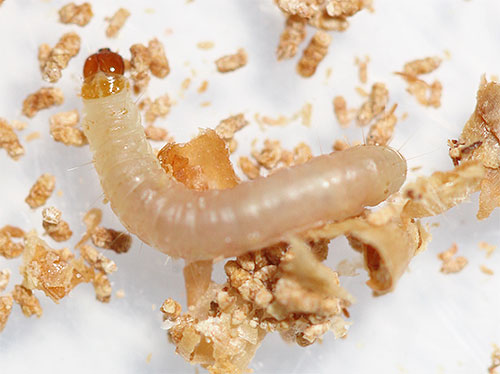
On a note
It is moth-infested and re-cleaned products that enter the market at bargain prices - because they need to be sold somehow. And by buying them, an ordinary city dweller risks bringing a pest into his house with them.
The food moth does not eat clothes and is not dangerous to the wardrobe. This, however, does not mean that in the presence of food moths in the room you should not worry about things: clothes and food moths do not interfere with each other and may well cohabit in the same apartment, while individuals of food moths will mostly catch your eye. In any case, you need to remove the mole from the very first signs of its detection in the house.
Fighting food moth: measures and means
It is necessary to fight food moth at all stages of its development. The statement that if only the larvae are harmful, then only they need to be destroyed: each flying female moth lays up to 160 eggs in different places, from which new caterpillars will hatch within a week.
Therefore, it is necessary to destroy the food moth in a complex:
- First you need to find the sources of development of the larvae - sort through all the food products in which the caterpillars can live, carefully check all the old food stocks. If contaminated products are found, throw them out or heat them in the oven at a temperature of at least 60 ° C for half an hour. This is the most reliable way to get the bulk of the pests out of the house.
- To destroy eggs, larvae and adult butterflies in kitchen cabinets and bedside tables, their surfaces must be treated with aerosol insecticides - Armol, Antimol, Raptor from food moths, Kombat. It is not necessary to choose especially carefully how to poison food moths - the destruction of food moths with aerosol preparations implies a kind of “auxiliary” operation, in which only a very small part of insects die. During this operation, it is important to prevent the poison from getting on food.

- Adult butterflies flying around the kitchen can be destroyed with sticky fly tapes, fly swatters and a simple newspaper. They fly badly and cannot even slip away from the sneaker. Food moth traps are also good, specially designed to attract adults.
A good moth trap is the Aeroxon food moth trap. It attracts butterflies with its smell, and its adhesive surface does not dry out for a long time. You can buy such a food moth trap online or in some hardware stores. Its cost is about 200 rubles:
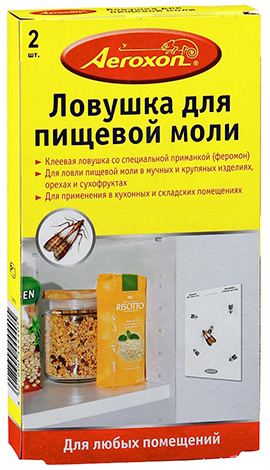
Simpler methods of dealing with food moths have not yet been developed. At industrial enterprises, moths are treated with phosphine-based fumigators and spraying grain with contact insecticides. It is impossible to carry out such processing of food indoors.
Measures to protect the home from food moth infestation
Knowing how to kill food moths is useful, but not enough to protect the premises from the pest. It is much more reasonable not to let him into the house at all, taking several steps to prevent infection of the apartment with food moths. Among these measures:
- careful check of all products upon purchase
- avoidance of underpriced groceries
- buying food that will be eaten within one week
- use of moth repellents.
To comply with the last point, it is useful to know what the food moth is afraid of. Among the substances that repel her are strongly smelling herbs (wormwood, tansy, lavender, rosemary), essential oils, fresh orange peels, laundry and strawberry soap, vinegar, horse chestnut cones.


It is only important to remember that if, for example, a jar of moth-infected semolina is placed in a cupboard with neatly laid out lavender, the larvae in the croup will not die, and the butterflies that appear later will no longer be afraid of the lavender itself. That is why it is so important to implement all preventive measures in the complex.

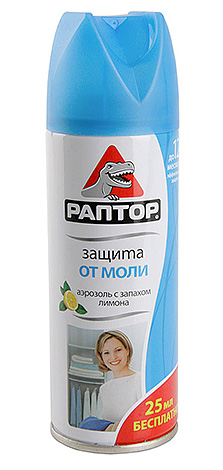
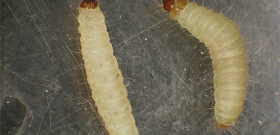
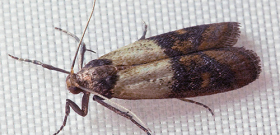
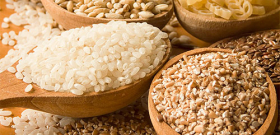
The best way to get rid of moths is to hang yourself. True, then worms will start eating you, but that's a completely different story ...
So that the worms do not eat, it is better to burn the old body.
She even has soda! SODU, Carl! This is tin.
And he eats mustard powder, only on the way.
Once a year I do the following in the summer. I pull food out of all cupboards. I wipe the cabinets dry, spray them. I open all the doors and windows wide open. I ventilate until morning. I put everything back in the morning. Already 15 years.
I pulled out all the food, tables, sofas, but she (moth) dragged everything back ... Like this, which means that there is only one way out - to change housing, where she has not yet had time to register ...